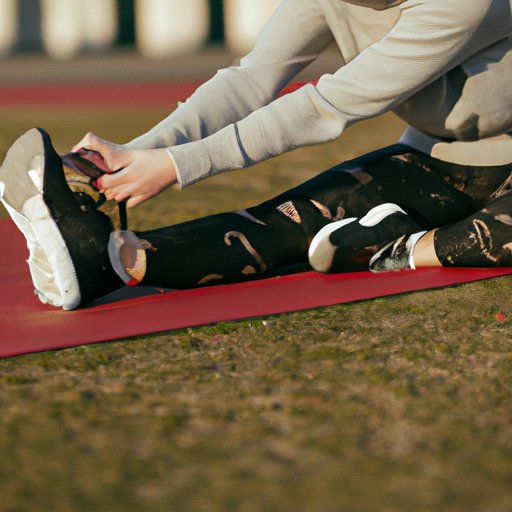Introduction
Flexibility is an important aspect of physical fitness and overall wellbeing. It refers to the range of motion in a joint or series of joints, and the length of muscles that cross the joints to induce a bending movement or motion. Having increased flexibility can help improve posture, reduce the risk of injury during physical activity, and even improve mental health and stress levels.

How to Achieve Improved Flexibility in a Timely Manner
While it’s important to remember that everyone is different and will have varying levels of flexibility, there are some best practices for becoming more flexible faster. Here are some tips that can help:
Best Practices for Becoming More Flexible Faster
First, warm up before any type of physical activity. Warming up helps to prepare your body for stretching and exercise, allowing your muscles to become more supple and easier to stretch. Stretching when your muscles are cold can lead to injuries.
Second, be consistent with your stretching routine. It’s important to stretch regularly in order to see results. Aim for at least three times a week, but make sure to give yourself rest days in between.
Third, focus on breathing while stretching. Breathing deeply and evenly helps to relax your body and muscles, which allows them to stretch more easily.
Finally, listen to your body. Don’t push yourself too hard and try to avoid straining your muscles. If you feel any pain or discomfort, stop and take a break.
Evaluating Different Routines and Methods to Increase Flexibility
When trying to increase flexibility, it’s important to evaluate which routines and methods work best for you. This means taking the time to experiment with different types of stretches and exercises, as well as finding out which ones you enjoy the most. Different stretches target different muscle groups, so it’s important to find a routine that works for you.
A Guide to Stretching Effectively for Maximum Flexibility
Stretching is an important part of increasing flexibility, and there are certain ways to ensure that you’re stretching effectively. First, always warm up before stretching by doing light aerobic activity such as walking or jogging. This helps to prepare your muscles for stretching and reduces the risk of injury.
Second, hold each stretch for 15-30 seconds. This gives your muscles enough time to relax and lengthen, leading to improved flexibility.
Third, don’t bounce while stretching. Bouncing puts unnecessary strain on your muscles and can lead to injury. Instead, move slowly and gradually into each stretch until you feel a gentle pull.
Finally, focus on breathing while stretching. Inhale and exhale deeply and evenly to help relax your body and muscles, allowing them to stretch more easily.
Creating a Flexibility Training Plan That Works For You
Having a regular flexibility training plan is key to improving flexibility in a timely manner. Here are some tips for creating an effective flexibility routine:
Understanding the Physical and Mental Benefits of Flexibility Training
First, it’s important to understand the physical and mental benefits of flexibility training. Increased flexibility can improve posture, reduce the risk of injury during physical activity, and even improve mental health and stress levels. Knowing these benefits can help motivate you to stay consistent with your flexibility training plan.
Identifying Your Goals for Increased Flexibility
Second, identify your goals for increased flexibility. Do you want to be able to touch your toes? Or do a full split? Having specific goals in mind can help you design an effective routine and stay motivated.
Designing an Effective Flexibility Routine
Third, design an effective flexibility routine. Start by incorporating stretching into your warm-up and cool-down before and after physical activity. Then, add in specific stretches that target the areas you want to work on. Finally, include other activities such as yoga or Pilates that can help improve flexibility.
Incorporating Flexibility Training into Your Exercise Regimen
Fourth, incorporate flexibility training into your exercise regimen. Make sure to schedule in regular flexibility sessions, and aim to do them at least three times a week. This will help you stay consistent and make progress towards your goals.
Conclusion
Increasing flexibility can take some time, but it’s worth it in the end. There are many physical and mental benefits of having increased flexibility, and following the tips outlined above can help you achieve improved flexibility in a timely manner. Remember to listen to your body, focus on breathing, and create a flexibility training plan that works for you.
(Note: Is this article not meeting your expectations? Do you have knowledge or insights to share? Unlock new opportunities and expand your reach by joining our authors team. Click Registration to join us and share your expertise with our readers.)
